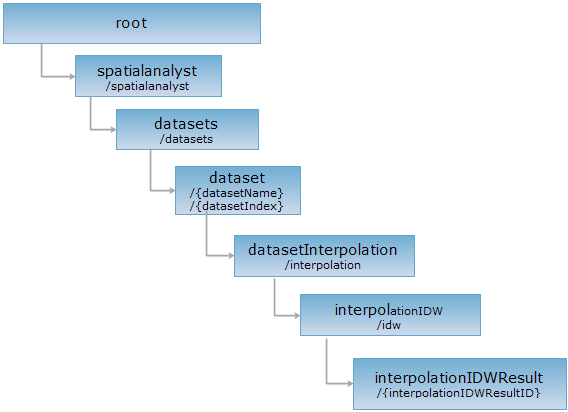
<interpolationIDW_uri>/{interpolationIDWResultID}[.<format>]
The result results of inverse distance weighting interpolation, used to get the inverse distance weighting interpolation result.
Supported methods
Supported output formats:(rjson, json, html, xml, jsonp).

Below is an example of performing an HTTP request on a specified URI with rjson as the output format. supermapiserver in the URI is the name of the server.
http://supermapiserver:8090/iserver/services/spatialanalyst-sample/restjsr/spatialanalyst/datasets/SamplesP@Interpolation/interpolation/idw/mi92arb7_ced19c5194e54209bd9112871f34f7c9.rjson
Returns the result resource of inverse distance weighting interpolation analysis.
Normal response code(s): 200.
| Name | Type | Description |
| succeed | boolean | Whether the interpolation analysis is successful. |
|
message |
String | The information returned when the interpolation analysis failed. |
| dataset | String | The ID of the result dataset. |
| recordset | Recordset | The result record set for storing information of the spatial objects. |
Implement GET request on the result resource of interpolationIDW resource POST results: http://localhost:8090/iserver/services/spatialanalyst-sample/restjsr/spatialanalyst/datasets/SamplesP@Interpolation/interpolation/idw/mi92arb7_ced19c5194e54209bd9112871f34f7c9.rjson, the response in rjson format is as follows:
{
"dataset": "test@Interpolation",
"message": null,
"recordset": null,
"succeed": true
}
Asks for the response identical to the one that would correspond to a GET request, but without the response body. This is useful for retrieving meta-information written in response headers, without having to transport the entire content. The meta-information includes the media-type, content-encoding, transfer-encoding, content-length, etc.
HEAD request can be used to check if the interpolationIDWResult resource exists, or if the resource can be accessed by clients. It can also determine if the interpolationIDWResult resource supports an output format <format> if performed on a URI with .<format> included.